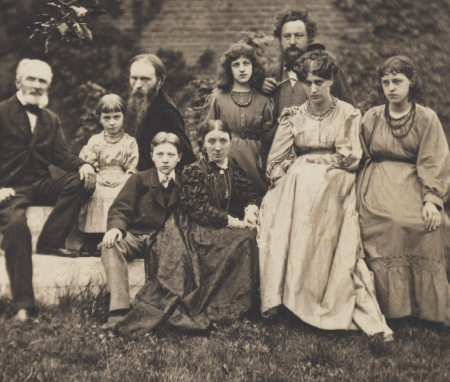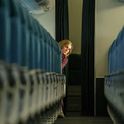Among the sketches included in George du Maurier’s English Society at Home (1880) is a plate that appears under the heading “Refinements of Speech.” The “Fair Æsthetic” in the image—a haggard and emaciated middle-aged woman, tightly draped in what looks suspiciously like a curtain—is saying, “suddenly, and in deepest tones,” to a Mr Smith, whom she has just met: “are you Intense?”
The recipient of these eager, urgent words looks somewhat taken aback. He has evidently not fallen in with the mid-to-late 19th-century fashion for intensity—instead, he looks rather immune to the female figure’s apparent penchant for strong, violent or excessive feeling. To be “intense” in this period was to manifest excitability alongside a dedicated sense of aesthetic or intellectual purpose. It was a key word for John Ruskin, whose celebration of an “intense disposition for art” and its capacity to “conquer the most formidable obstacles” proved decisive for many, including the Oxford undergraduate William Morris—especially in the context of what it meant to be “at home.”
Intensity and domesticity have always governed the popular image of Jane Morris, wife of William. A thrilled young Henry James wrote to his sister Alice about an encounter with her at her London residence in 1869 that:
she haunts me still… an apparition of fearful and wonderful intensity… Imagine a tall lean woman in a long dress of some dead purple stuff… with a mass of crisp black hair heaped into great wavy projections on each of her temples, a thin pale face, a pair of strange sad, deep dark Swinburnian eyes… in fine Complete.
Born in Oxford in 1839, Jane Burden was the daughter of an illiterate domestic servant and a stable hand. (A blue plaque erected by the William Morris Society now marks the place of her birth in St Helen’s Passage, commemorating her as “Pre-Raphaelite Muse and Embroiderer.”) She seemed destined for a life of wearying hardship and deprivation until, famously, she was spotted aged 17 at the theatre by Morris’s friends and artistic collaborators Dante Gabriel Rossetti and Edward Burne-Jones. As one of their top adolescent “stunners” (Rossetti’s word), Jane Burden modelled for all three men while they laboured to produce a series of Arthurian murals for the Oxford Union debating society, her extraordinary beauty resulting not only in the first of many solemn, regal portraits but in a proposal of marriage from Morris.
He was wealthy, and it was a triumphant match for a girl from such a humble background, but according to some later accounts Jane Morris did not love her husband. In the early 1860s she gave birth in quick succession to two girls, Jenny and May, before succumbing to illness and invalidism. Whatever the origins of her debilitating ailments, she subsequently embarked on two affairs, first with Dante Gabriel Rossetti and then with the philandering, anti-imperialist poet Wilfrid Scawen Blunt. Morris, an explosive workaholic, cannot have been easy to live with. “He swears awfully,” as Algernon Swinburne (hardly renowned for good behaviour himself) reported to a friend, “and walks with a rolling gait as if partially intoxicated.”
It was the great good luck as well as the misfortune of these women to have been singled out on the basis of their looks
Morris’s sudden rages were probably related to an epileptic tendency inherited from his mother and in turn passed on, in a more severe form, to his elder daughter Jenny, whose condition developed in her late teens. Jenny needed to be cared for throughout her adult life, and much of the latter part of Suzanne Fagence Cooper’s new biography details the increasingly distressing fits and episodes of illness from which she suffered. May Morris, the younger daughter, imbibed her father’s socialist ideals as well as practising the devotion to craft exhibited by both her parents. Her own exquisite skills as an embroiderer, like those of her mother, have tended until recently to be overshadowed by the achievements of her father.
So little is known of Jane Morris’s early, unsettled life that it can be reconstructed only in broad and speculative terms. When she married Morris in 1859, she seems to have renounced her past, not even returning home to see her mother when she was dying. Perhaps William’s commitment to the working poor did not extend as far as a willingness that his wife should remain in touch with her own roots. Yet Jane’s sister Bessie Burden worked for Morris’s firm as an embroiderer and sometimes lived with them in London (she later became an accomplished teacher at the Royal School of Needlework), so Jane Morris’s break with her family was not complete. Perhaps it was she herself who wished to forget or gloss over where she had come from. She learnt French and Italian and read widely; at least equally importantly, she excelled, like her sister, at needlework.
Ruskin’s emphasis on workmanship—on the inseparability of art from its practical and manual execution—had amounted, for William Morris, to a “sort of revelation.” He and his wife spent the rest of their lives working out the political and domestic implications of reviving and experimenting with such traditional crafts as embroidery, mural painting, the production of furniture, glass, jewellery, textiles and bookmaking. All this activity, Morris later wrote, aimed simply to produce “something which, when done, shall give pleasure to the user of it”; every true work of art sprang from “taking a genuine interest in all the details of daily life.” Their friends often joined them in these labours, Burne-Jones’s wife, Georgie, remembering “how happy we were, Janey and I, busy in the morning with needlework or wood-engraving.” Although Jane was actively involved in many such endeavours, she did not share her husband’s revolutionary views or endorse his vision of a society in which, as he put it, “there should be neither rich nor poor, neither master nor master’s man, neither idle nor overworked, neither brainslack brain workers, nor heartsick hand workers, in a word, in which all men would be living in equality of condition.”
Many other books have been published about the Morrises, whether as a couple or as part of a larger group of Victorian artists and their models; Cooper’s sympathetic account draws frequently on these earlier studies. But her dual biography has been primarily enabled, as she acknowledges, by Frank C Sharp and Jan Marsh’s pioneering, fully annotated edition of Jane Morris’s letters, which appeared in 2012. That volume told us something of its subject’s response to Rossetti’s art (she thought his early paintings his best) and about how she approached her curatorial role after Morris’s death. But there remain enormous gaps in the record: no letters survive from Jane to William, nor any from her to Rossetti until their affair was long over. Many of the letters consist of rather flat, dreary accounts of health problems and complaints about the weather.

and Morris (right) families in 1874. Image: National Portrait Gallery
Cooper frequently upbraids earlier writers and artists for treating Jane and other working-class female models as if they were “blanks.” She means that Pre-Raphaelite painters were uninterested in, or even acted to suppress or erase, the real histories of the women whose beauty they celebrated in their works. But would we know anything at all about Jane Morris or Lizzie Siddal if they had not appeared in such pictures? They were elevated to public notice by artists whose attitudes to their muses were no doubt imperfect, sometimes reprehensible; but it was the great good luck as well as the misfortune of these women to have been singled out for such attention on the basis of their looks alone.
Cooper is no doubt right to argue that Jane and other female models had their own “skills and opinions”; however, such traces of their personalities can prove hard to recover. How We Might Live aspires to “bring Jane back into focus, travelling alongside William in the art of living well, living differently”; but, in attempting to do this, the author is driven to acts of imaginative or novelistic reconstruction that aren’t always persuasive or relevant: “Jane was more alive playing hide-and-seek in her darkened spare bedroom than she would ever be, pretending to be Pandora”; “Jane leant against the tree-trunk, her book open in her lap. It felt good to be sitting in the green shade beneath the canopy of leaves”; “Jane lay awake in the dark, listening to the unfamiliar scuttlings and rustlings, breathing in the strange scents.”
A younger friend of Jane reported that “one of the chief reasons for the great sympathy and attraction which she and Rossetti had for each other was their mutual sense of humour,” but—despite Cooper’s warm insistence that Jane is “unexpectedly funny”—there is very little evidence of her comic tendencies or aptitudes in this book. What people say of her, time and again, is that she was extraordinarily taciturn, “the silentest woman” that George Bernard Shaw had ever met. It seems to have been a natural inclination on her part to be quiet, one which her daughter May inherited; it does not necessarily imply suppression or unhappiness. Perhaps Jane simply did not like to say much. When she died in 1914, an obituarist in the Times heralded her abilities as an embroiderer and the face for which she had been renowned, before adding: “only her intimate friends knew the kindliness, the good sense and the girlish love of fun, which remained until the end of her life.” Cooper’s response to these words is that Jane Morris “was silenced for so long.” It seems more accurate to say that she kept her own counsel, and is still keeping it now.












